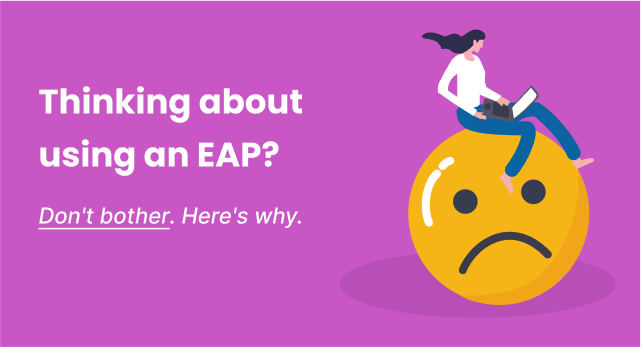A quick summary:
On paper, Employee Assistance Programmes (EAPs) seem like the silver bullet to best-in-class employee wellbeing. They claim to support employee mental, emotional, and physical wellbeing, they can be inexpensive, and they’re used by so many organisations out there.
So that must mean that they work well, right? Wrong. Here’s the simple truth.
No one uses them.
You heard that right. In fact you can bet that most of your employees don’t even know what an EAP even is.
Don’t believe me? Well read on, my curious reader. And don’t worry, I’ve got some suggestions on employee benefits that people actually use at the end of this article.
Do EAPs even work?
If you’re an employer then the concept of an EAP probably sounds quite sexy. But a vast amount of employees who have access to an EAP don’t actually know how they even work. Some employees even think that they have to pay to use an EAP.
A quote from Jack Latus’s article in HR Magazine comes to mind:
“[EAP’s are] a performative way for employers to demonstrate that they care about their employees that doesn’t actually benefit them all that much, and holds HR teams back from achieving their full potential within the workplace.”
In truth, many organisations simply have an implemented EAP because they assume it works. Not because it actually does.
In fact, according to research by the UK Employee Assistance Professionals Association, only 9% of HR managers even attempt to measure the effectiveness of their EAP.
So why is that? Because EAPs make it complicated to measure their effectiveness on purpose. Because if you can’t measure it, then you can’t say that they don’t work.
The REAL solution? Give your employees benefits tailored to them. Take the time to provide a wellbeing improvement scheme that shows that you care. And yes, it’s not easy but there are platforms out there that can help. (Psssst. Heka is one of them 😉).
Are Employee Assistance Programmes Confidential?
When it comes to wellbeing - particularly mental health, it can be very personal. Perhaps an employee is facing mental health challenges due to the workplace, workload, colleagues, or management. And so employees can have hesitations when it comes to reaching out to mental health support provided through EAPs.
And it makes sense. Is it really confidential? Will my employer find out? Am I better off going private? These are all questions your employees are going to be asking themselves.
Even outside of mental health support, employees don’t want to think that their employer is tracking the purchases they are making, spending habits or where they like to shop. For some people, it's not worth taking the risk just in case their employer is keeping tabs of them.
While EAPs claim tobe a simple case of “plug-in and play”, they are actually going to require a ton of internal marketing effort to clearly outline how it works, why it’s useful and how to use it.
The problem? People move jobs, new people join, and before you know it you’ve got entire teams of employees who don’t know what your EAP is and how it works.
Employee Wellbeing is not “One-size-fits-all”
Each and every one of your employees have their own preferences, hobbies, interests, and struggles. You can’t expect every employee to desire the same rewards and benefits that make them happy and healthy. That’s where EAPs fall short.
EAPs masquerade as something employees LOVE. And sure, oftentimes getting a bit of discount here and there from some highstreet stores can be nice (depending on whether or not you meet the discount requirements). But in reality, tons of jobs such as Emergency Services or Armed Forces have had this sort of “benefit” for decades.
Yet despite this, The Business Group on Health’s 2024 Large Employer Health Care Strategy survey found that 77% of employers are reporting an increase in employee mental health needs.
So how can you do better?
Your employees are all individuals and so making sure that you provide a tailored solution to employee benefits is the best way to make a positive impact. (Spoiler alert: That’s what we do.)
Best ways to improve employee wellbeing without an EAP
While the intention behind Employee Assistance Programmes is commendable, there’s significant shortcomings that hinder their ability to genuinely enhance employee happiness at work. To create a positive shift, employers must transition from reactive, one-size-fits-all approaches to proactive, personalised solutions.
By integrating wellbeing into the company culture, addressing privacy concerns, and focusing on long-term solutions, your employee wellbeing is going to drastically improve. It's time to move beyond the limitations of traditional EAPs and embrace a holistic approach to employee wellbeing.
That’s what Heka does.
Think of Heka like a virtual candy store. You're the parent, and your employees are the kids. All you do is hand out how much budget you’re happy for them to spend and they can choose to buy anything they want that makes them happy.
Sounds great for people with a sweet tooth, right? But Heka isn’t just a candy store. It’s a hive of experiences, memberships, products, and services.
That’s to say, your employees aren’t confined to specific employee benefits. They have the choice.
Book a demo to see how Heka can improve your employee wellbeing.
.svg)




